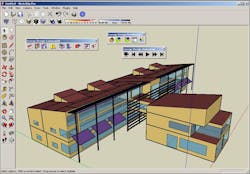DOE, Autodesk team to overhaul the EnergyPlus simulation program
By Jeff Yoders, Contributing Editor
This article is part of BD+C's special five-part Technology Report 2014: Top tech tools and trends for AEC professionals.
For more than a decade, the U.S. Department of Energy has made its EnergyPlus energy analysis and thermal load simulation program available for free to Building Teams.
Using EnergyPlus, AEC professionals can model heating, cooling, lighting, ventilation, and other energy flows, as well as water consumption, within a building design.
But without a major rewrite of the program since its creation, using EnergyPlus could exhibit slow performance and occasionally inaccurate analysis results.
The programming language it was originally written in, Fortran, simply could not keep up with advances in the hardware and software computing environment. FORTRAN is a language aimed at scientific programs to be run by scientists for days and weeks on supercomputers, not by building designers running multiple iterations of a design idea in a matter of a few hours.
Because it wasn't well integrated with common architectural design software, EnergyPlus never gained widespread adoption by architects working in the conceptual stage of a project.
At Greenbuild 2013, Autodesk (working pro bono) turned over brand new engine source code to the DOE to create a completely rewritten EnergyPlus for a forthcoming version. The new code will be made available under the DOE’s open source license.
Autodesk’s software engineers translated EnergyPlus—more than 600,000 lines of code—to C++, a modern, object-oriented language that is better supported on mass-market hardware and software platforms.
As a result, a larger ecosystem of developers and vendors will be able to contribute updates to the code in order to improve performance and decrease the time required to run energy model simulations.
The forthcoming version will also work better with BIM applications, auditing tools, and energy dashboards after it is released and developers are able to work on improved integrations.
For more, visit: http://apps1.eere.energy.gov/buildings/energyplus.
